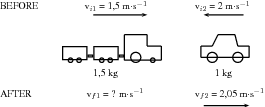| << Chapter < Page | Chapter >> Page > |
This equation is always true - momentum is always conserved in collisions.
A toy car of mass 1 kg moves westwards with a speed of 2 m s . It collides head-on with a toy train. The train has a mass of 1,5 kg and is moving at a speed of 1,5 m s eastwards. If the car rebounds at 2,05 m s , calculate the velocity of the train.

We will choose to the east as positive.
A helicopter flies at a speed of 275 m s . The pilot fires a missile forward out of a gun barrel at a speed of 700 m s . The respective masses of the helicopter and the missile are 5000 kg and 50 kg. Calculate the new speed of the helicopter immmediately after the missile had been fired.

= 5000 kg
= 50 kg
= = 275 m s
= ?
= 700 m s
The helicopter and missile are connected initially and move at the same velocity. We will therefore combine their masses and change the momentum equation as follows:
Note that speed is asked and not velocity, therefore no direction is included in the answer.
A bullet of mass 50 g travelling horizontally at 500 m s strikes a stationary wooden block of mass 2 kg resting on a smooth horizontal surface. The bullet goes through the block and comes out on the other side at 200 m s . Calculate the speed of the block after the bullet has come out the other side.

We will choose to the right as positive.
A very important application of impulse is improving safety and reducing injuries. In many cases, an object needs to be brought to rest from a certain initial velocity. This means there is a certain specified change in momentum. If the time during which the momentum changes can be increased then the force that must be applied will be less and so it will cause less damage. This is the principle behind arrestor beds for trucks, airbags, and bending your knees when you jump off a chair and land on the ground.

Notification Switch
Would you like to follow the 'Maths test' conversation and receive update notifications?